Week 2 - Membrane Proteins and Transport Across Membranes
1/72
There's no tags or description
Looks like no tags are added yet.
Name | Mastery | Learn | Test | Matching | Spaced |
|---|
No study sessions yet.
73 Terms
How important are proteins in the permeability of the lipid bilayer?
Very important!
Proteins help conduct facilitated transport, making the membrane permeable to most water soluble molecules.
Without proteins, the membrane is impermeable to most water soluble molecules.
What types of molecules are permeable across lipid bilayers?
Small non-polar molecules
Small uncharged polar molecules
Which of the two permeable molecules is the most permeable?
Small non-polar molecules.
*see arrows in the image, the size indicates permeability (big arrow = super permeable, small arrow = low permeability).
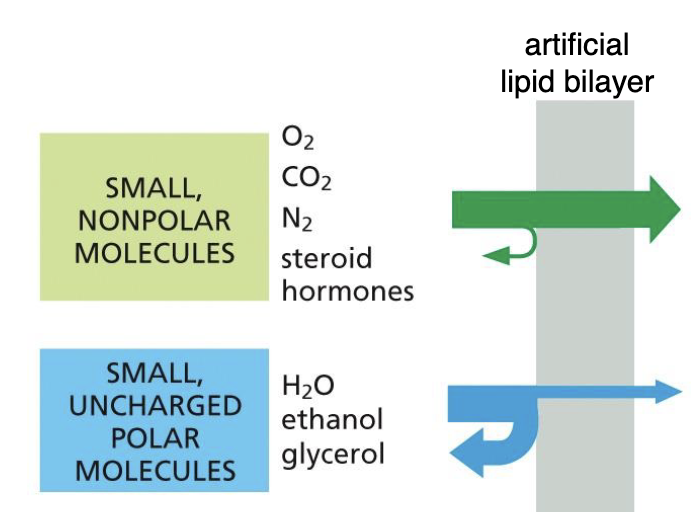
What types of molecules are impermeable across lipid bilayers?
Larger uncharged polar molecules
Ions

What are permeable molecules?
When the molecules move via simple diffusion through the lipid bilayer along the concentration gradient.
What direction does simple diffusion occur?
High concentration to low concentration (along/down the concentration gradient— meaning no ATP is required).
How does the presence of hydrophobic molecules and non-polar molecules affect rate of diffusion?
Their presence makes the rate of diffusion faster.
What are impermeable molecules?
Molecules that require transport proteins to move them through the lipid bilayer.
What are transmembrane transport proteins?
They create a protein-lined path across the cell membrane to help impermeable molecules pass through the lipid bilayer.
This makes sense as transmembrane proteins are a type of integral protein that goes completely through the cell membrane.
What are the characteristics of transmembrane transport proteins?
They are selective where they only transport a specific class of molecules
sometimes they only transport calcium ions (super specific), or only ions (not as specific)
therefore, the specificity and degree of specificity changes depending on the protein
What are the 2 main classes of transport proteins?
Channel Proteins
Transporter Proteins (aka. carrier proteins)

What do channel proteins do?
Channel proteins bind weakly to the molecule needing to be transported and does not change in conformation a lot during transport.
What do transporter proteins do?
Transporter proteins bind strongly to the transported molecule and changes in conformation a lot during transport.
What is the selectivity of channel proteins based on?
size
electric charge of the solute
What is transportation of solutes by channel proteins like in comparison to transporter proteins?
channel proteins have very transient interactions with the solutes that pass through it (aka. weak and temporary)
channel proteins provide faster transportation than transporter proteins
channel proteins DO NOT undergo any conformational changes for transport through an open channel
They have a hydrophilic pore across the membrane.
What is the selectivity of transporter proteins based on?
If the solute fits into its binding site.
What is the transportation of solutes by transporter proteins like in comparison to channel proteins?
requires specific binding of the solute (aka. strong interactions form only with specific solutes that fit)
many conformational changes occur in order for transport to occur
Define passive transport.
Down the concentration gradient and does not directly require energy.
Define active transport.
Up or against the concentration gradient and does directly require energy.
What is a pump?
A type of transporter protein that requires active transport.

What creates an electrochemical gradient?

Define membrane potential.
The difference in charge across the membrane.
How does the electrochemical gradient affect permeability of membranes?
When the concentration gradient and membrane potential work in the same direction, the solute is more inclined to go through the channel proteins to the other side of the membrane
this is because the solute goes from high to low concentration (down the concentration gradient)
it also has an opposite charge on the other side of the membrane drawing it towards that side, making it more inclined to pass through
this is shown through the bigger arrow in A in the image
When the concentration gradient and membrane potential work in opposite directions, the solute is less inclined to go through the channel proteins to the other side of the membrane
this is because, although the solute is going from high to low concentration (down the concentration gradient), the other side of the membrane has the same charge as the solute
thus, repelling the solute and making it less inclined to go through the channel into that side of the membrane
this is shown through the smaller arrow in B in image
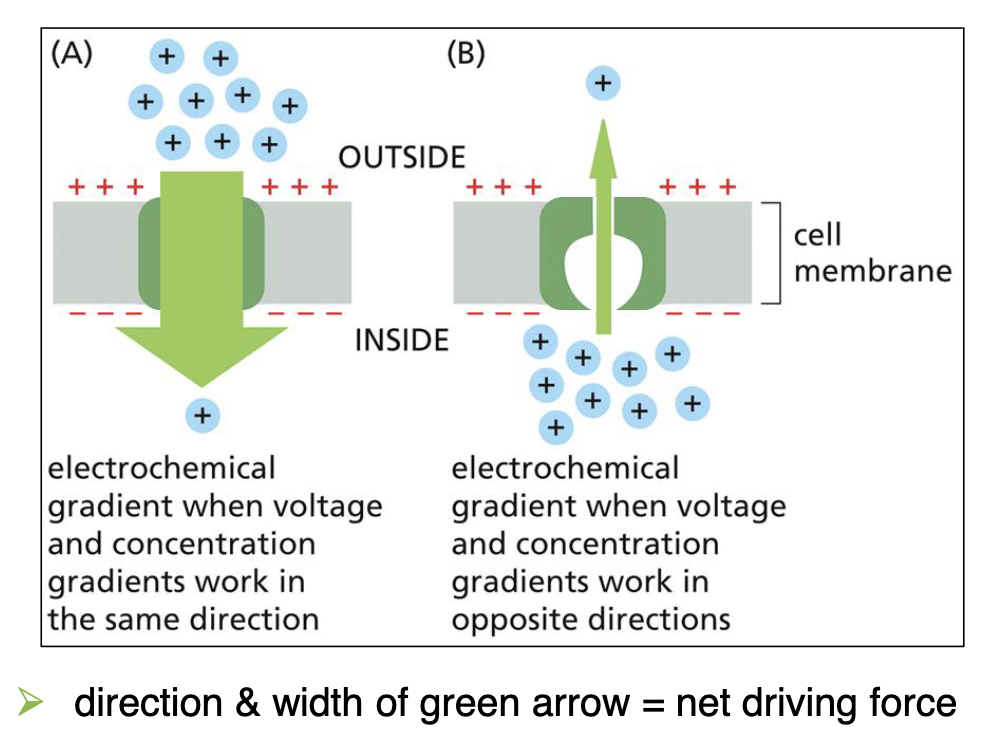
Which force is stronger in what determines the net driving force of solutes moving across membranes?
It depends on the magnitude of the concentration gradient or membrane potential.
However, usually in a cell, the concentration gradient is the one that makes a bigger impact.
Define an additive effect.
When the concentration gradient and membrane potential work in the same direction, making each factor help the other move the solute. Hence, having additive effects.
Where are ion channels found?
Animals
Plants
Microorganisms
What are the types of Ion channels?
Non-gated ions channels - always open
Gated ion channels - a specific signal is needed to open it
What is an example of a non-gated ion channel?
K+ Leak Channels
K+ moves out of the cell since the channels are always open
Therefore, it plays a major role in creating a resting membrane potential in the plasma membrane of animal cells
What are some examples of a gated ion channel?
Mechanically-gated
mechanical stress opens the channel
ie. stress receptors in your skin
Ligand-gated (extracellular ligand)
specific signal binds to the outside of the channel to open it
ie. neurotransmitters
Ligand-gated (intracellular ligand)
specific signal binds to the inside of the cell, making it open
ie. ion, nucleotide
Voltage-gated
a change in the voltage across a membrane makes the channel open
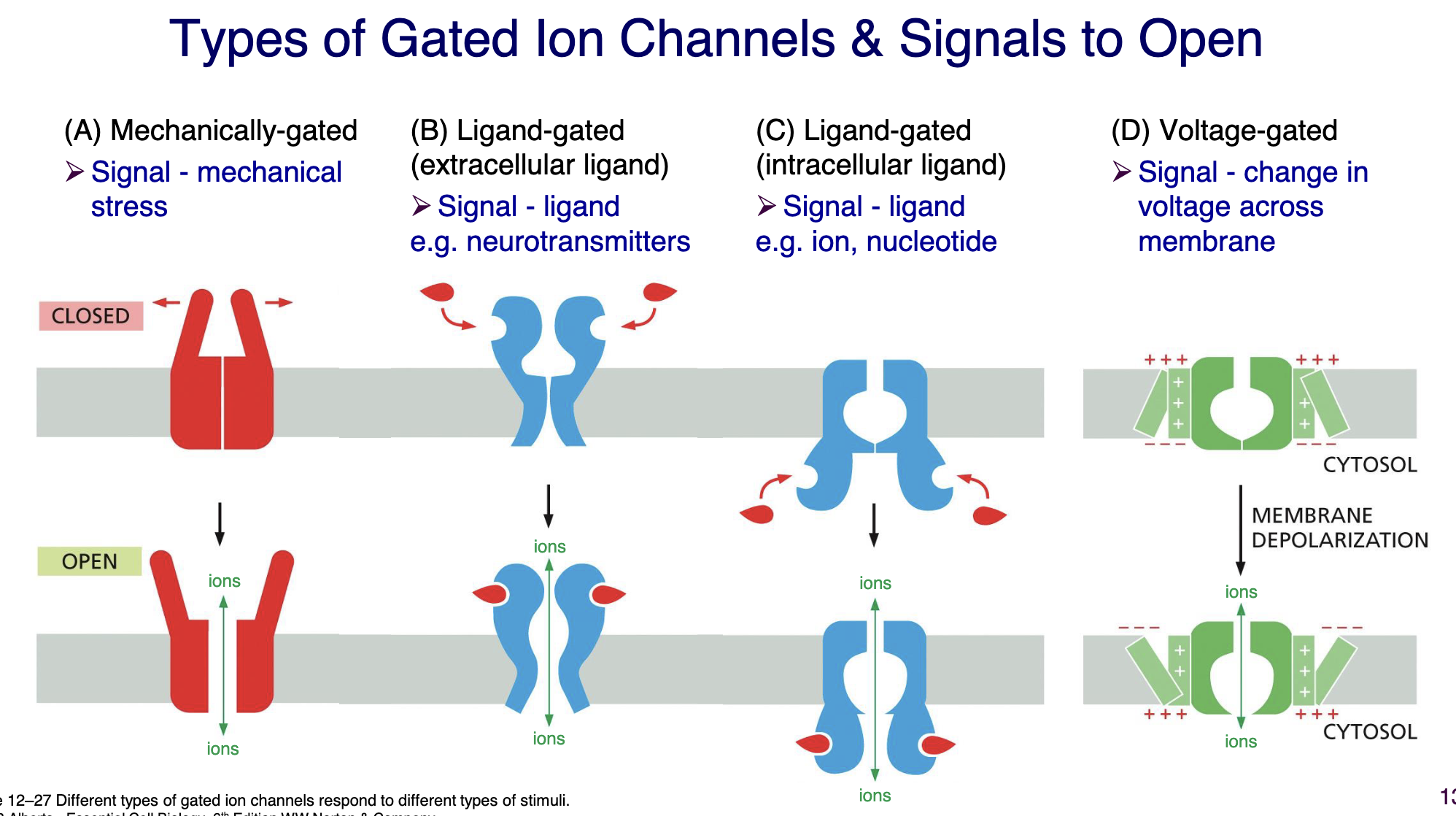
How do you read a transport protein graph?
y-axis
the rate of transport across a membrane
x-axis
how much of a molecule is on one side of the membrane (concentration)
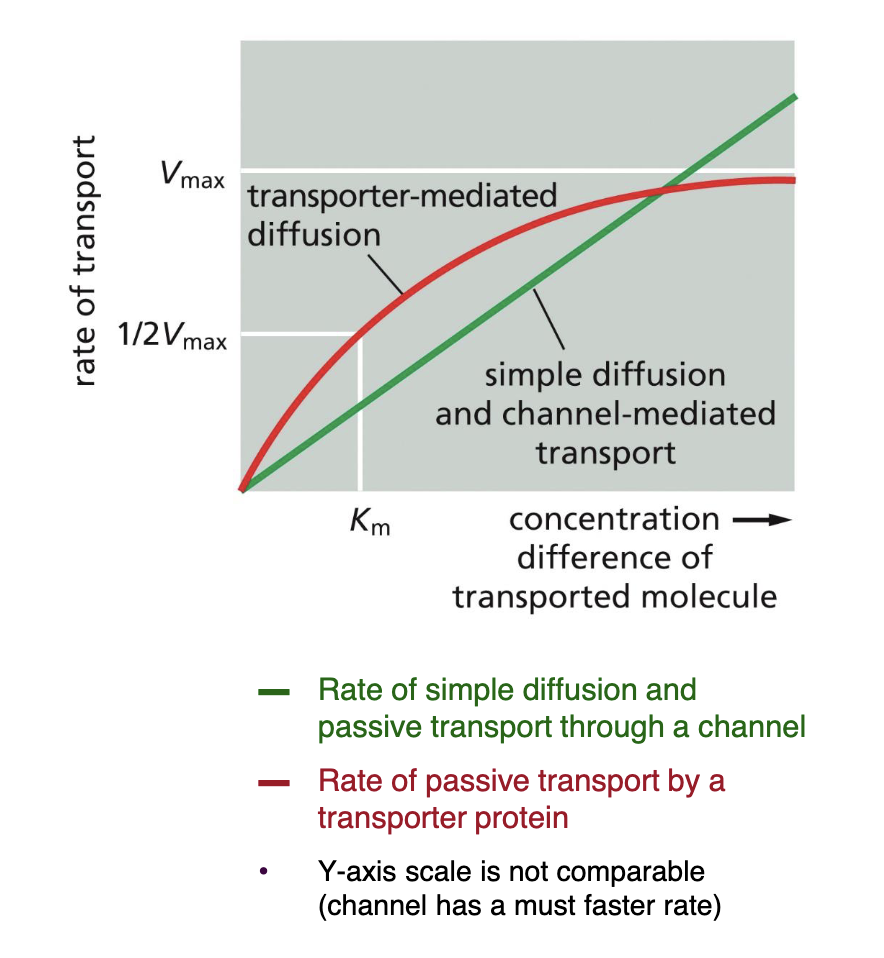
Why does the rate of transport via transporter proteins eventually plateau?
Because the transporter proteins bind to a specific molecule and go through a conformational change.
Hence, there is a maximum speed at which they can bind to specific molecules and change their conformation.
So even if the amount of molecules on one side of the membrane increases, there is only so fast that they can transport the molecules.
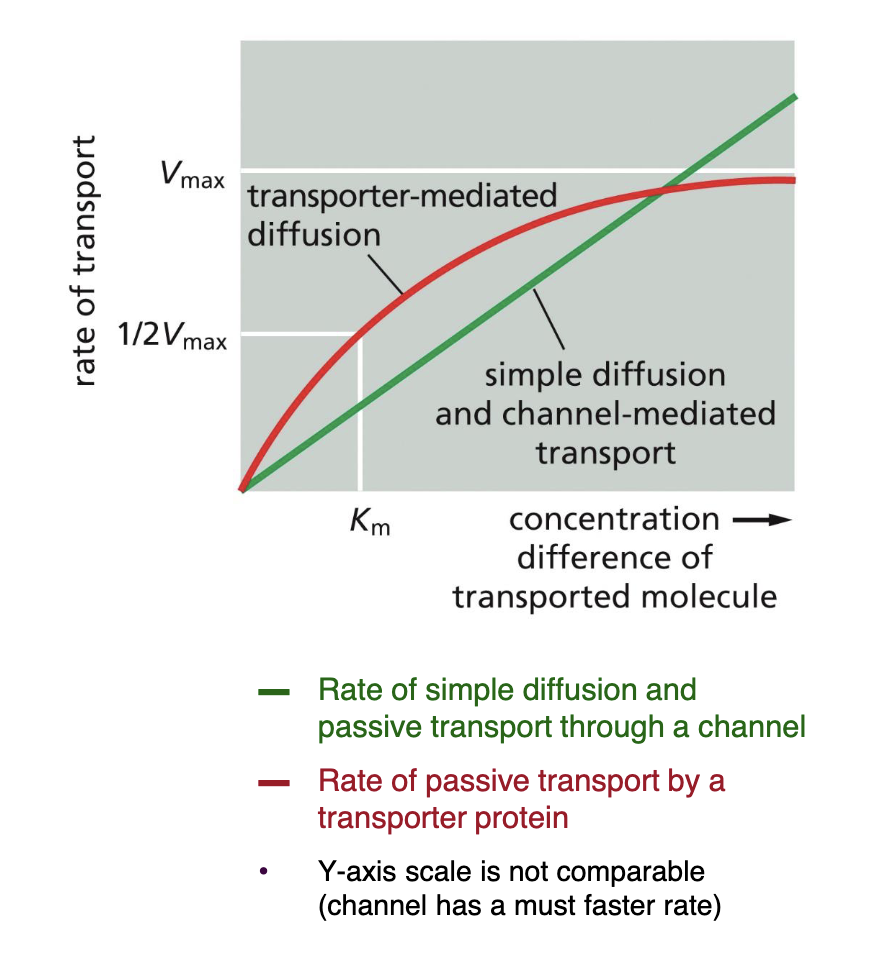
Why is the rate of transport via channel proteins infinitely increase?
Because they make weak bonds with the molecules and so the more molecules there are on one side of the membrane, the more molecules that the channel protein can transport. Hence, increasing the rate of transport infinitely.
Define a uniport transporter protein?
It transports one specific solute via passive transport down the electrochemical gradient.
*The direction of the transport is reversible.
What is an example of a uniport?
Glucose Transporter - GLUT Uniporter
transports glucose down the concentration gradient
can work in either direction (bringing glucose into the cell and out of the cell)
this is because, if you transport a lot of glucose into one side of the membrane, and therefore make that side have a higher concentration of glucose, the direction of the concentration gradient will reverse
Does the energy required in active transport require ATP specifically?
No, it just needs energy.
What modes of transport require active transport to go against the electrochemical gradient?
Gradient-driven pump
ATP-driven pump (ATPases)
Light-driven pump (bacteria)
How does a gradient-driven pump work?
the first solute goes down its electrochemical gradient creating energy (red blocks)
a second solute can then use that energy to go against its electrochemical gradient (yellow blocks)

How does an ATP-driven pump (uses ATPases) work?
uses ATPases to conduct ATP-hydrolysis which then gives solutes the energy to move against their electrochemical gradients
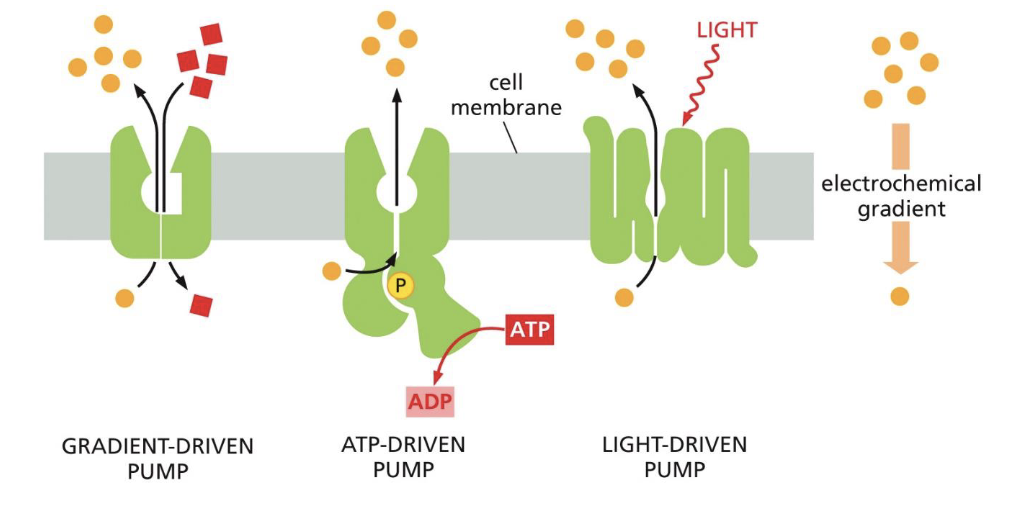
How do light-driven pumps (occurs in bacteria) work?
light energy is used to move solutes against their electrochemical gradient
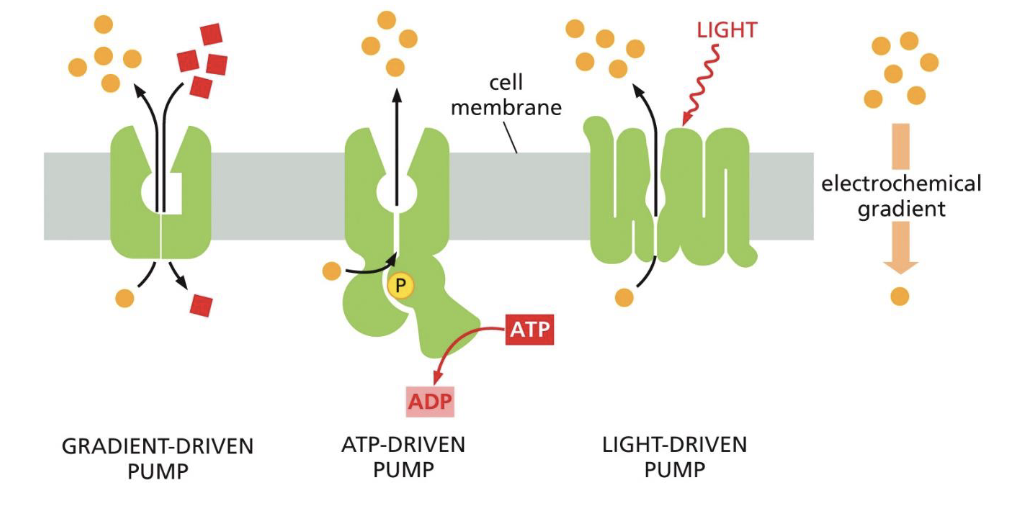
What are 2 types of gradient-driven pumps?
Symport
Antiport
Define symport.
When 2 solutes get moved in the same direction.
Define antiport.
When 2 solutes get moved in opposite directions.
1 goes in
1 goes out
How are symports and antiports similar?
They both use the energy generated from the 1st solute moving down its electrochemical gradient to transport a 2nd solute against its electrochemical gradient.
What is an example of a symport?
Na+ Glucose Symporter
Na+ goes down its electrochemical gradient providing energy (going into the cell)
that energy is used to move glucose against its concentration gradient (going into the cell to be used for energy)
Key notes seen in image:
random oscillations occur between conformations making the direction of transport reversible
conformational changes only happen when
both binding sites are occupied: cooperative binding of Na+ and glucose
both binding sites are empty: both Na+ and glucose dissociate
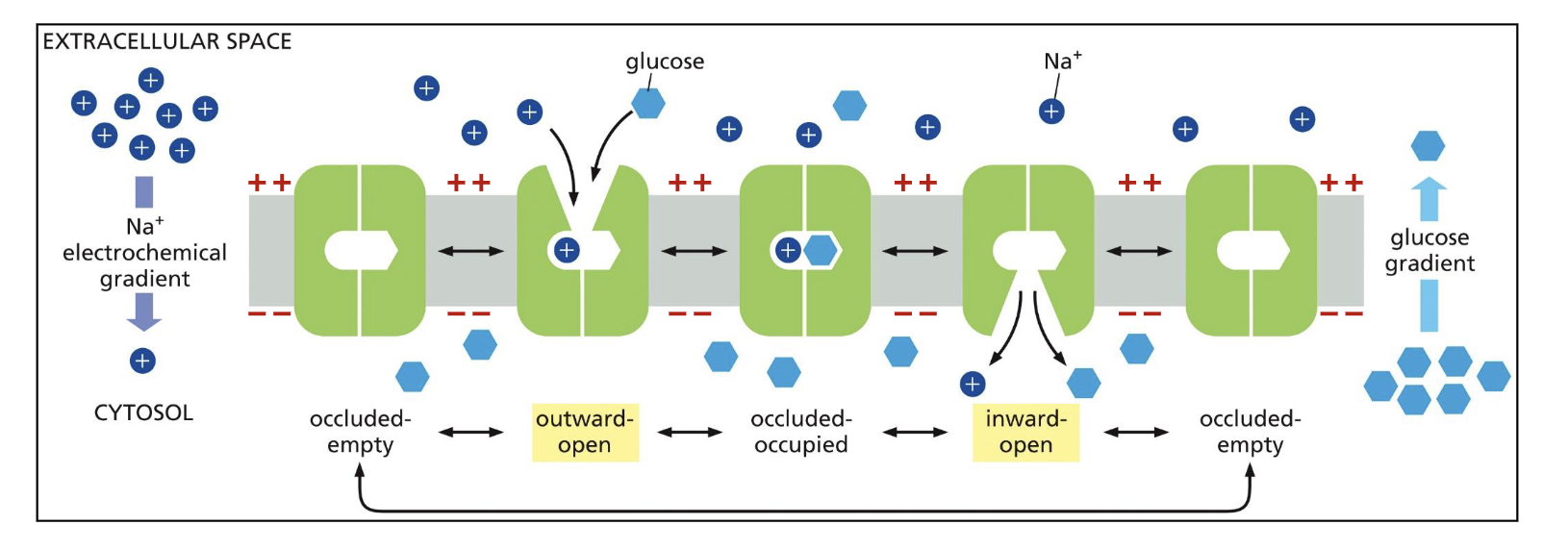
What is an example of an antiport?
Na+ and H+ Exchanger
Na+ goes down its electrochemical gradient providing energy (going into the cell)
that energy is used to move H+ against its electrochemical gradient (go out of the cell)
Why do we need to move H+ ions out of a cell?
It is because the pH of the cytosol needs to be around 7.2 for optimal enzyme function, but excess H+ in the cytosol messes that up.
For example, excess H+ in the cytosol can lead to acid forming reactions and things leaking out of lysosomes.
Hence, transporter proteins maintain the cytosolic pH by using the Na+ and H+ Exchanger in the plasma membrane which respond to drops in cytosolic pH levels.
Using the Na+ and H+ Exchanger, we will eventually run out of Na+. Therefore, how do we maintain Na+ electrochemical gradient?
A Na+-K+ Pump (sodium-potassium pump).
Those are ATP-driven pumps.
What are the 3 types of ATP-driven pumps?
P-type pump
V-type proton pump
ABC transporter
What are the characteristics of P-type pumps?
they use ATP
they phosphorylate (lose a Phosphate group) during the cycle
they transport ions
they also transport phospholipids (flippases is an example of an ATP-driven pump)
What is an example of a P-type pump?
A Na+-K+ Pump (sodium-potassium pump).
How does a Na+-K+ Pump (sodium-potassium pump) work?
3 Na+ ions inside the cell bind to the pump
This hydrolyses ATP where a phosphate group is cut off and added to the pump
The phosphorylation of the pump triggers a conformational change and causes the ejection of Na+
2 K+ from the outside of the cell then bind to the pump
This de-phosphorylates the pump where the Phosphate is removed
The 2 K+ then get released to the inside of the cell

What are 2 examples of how P-type pumps affect electrochemical gradients?
An example of a p-type pump is a Na+-K+ Pump in animal cells
from the pump, an Na+ electrochemical gradient is made and used to drive Na+ driven symports and antiports
hence, maintaining membrane potential as well
Another example of a p-type pump in a H+ pump in plant cells
from that pump, a H+ electrochemical gradient is made and used to drive H+ driven symports/antiports
this then helps maintain membrane potential too
How do V-Type proton pumps work?
They use ATP to move hydrogen ions against their electrochemical gradient (into the cell).
This is similar to Hydrogen ion P-type pumps. However, this one does not ‘pee itself,’ it does not phosphorylate.
How do ABC transporters work?
They use 2 ATP to pump small molecules across cell membranes.
How are the V-type proton pump and F-type ATP Synthase opposite from each other?
V-type proton pump:
uses ATP to pump hydrogen ions against their electrochemical gradient (into a cell)
F-type ATP Synthase:
hydrogen ions move down their electrochemical gradient to create ATP
the direction of transport is reversible as it depends on the hydrogen ion electrochemical gradient (think of ETC from Bio HL)
What is the apical side of a plasma membrane?
The region where the microvilli is facing the gut lumen.
What is the lateral side of a plasma membrane?
The region where the epithelial cells are facing epithelial cells right next to itself.
What is the basal side of a plasma membrane?
The region where the epithelial cells are facing the basal domain.
What is the term for the basal and lateral side?
Basolateral domain
What do tight junctions do?
They prevent glucose from going between epithelial cells and into the other side of the plasma membrane.
If tight junctions prevent glucose from going between epithelial cells and into the other side of the plasma membrane, how does glucose get out of a cell?
You must move the glucose through the epithelial cells and then to the outside of the cell.
This requires glucose to move from the gut lumen with a low glucose concentration to the epithelial cells with a high glucose concentration and then lastly, the extracellular fluid (outside the cell) with a low glucose concentration.
How is glucose transferred from our intestines to our bloodstream?
Na+-driven Glucose Symport
This is where sodium leaves the gut lumen (out of the cell) which is down its own concentration gradient, generating energy
That energy is then used to transport glucose also out of the gut lumen (out of the cell) and into the epithelial cell, which is against its own concentration gradient
A symport is used to move the molecules
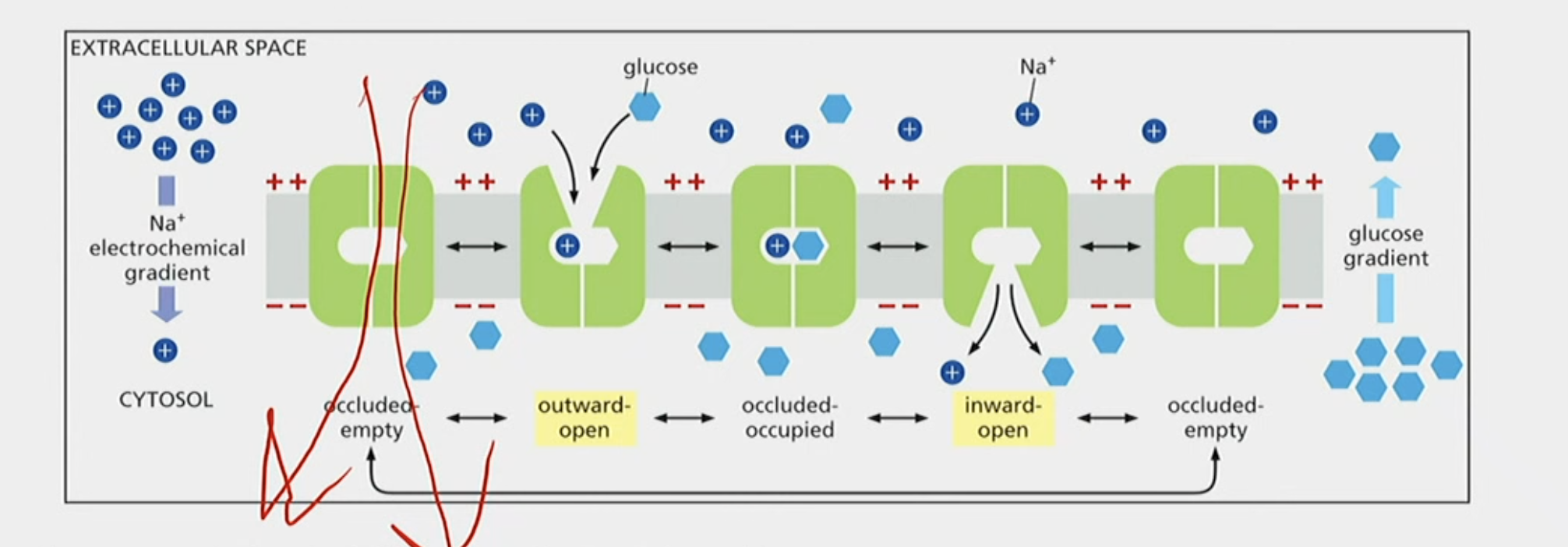
How is a low Na+ concentration maintained in the epithelial cell to ensure that Na+-driven Glucose Symport can be carried out to transport glucose?
A sodium potassium pump at the basolateral domain keeps the concentration of Na+ low in the epithelial cell.
Does the distribution of membrane proteins along the plasma membrane matter for the transcellular transport of glucose?
Yes, such transport requires the asymmetric distribution of membrane proteins.
Why does the transport of glucose require asymmetrical distribution of membrane proteins?
If you let the Uniporter onto the apical side of the epithelial cell, when glucose goes into the cell with sodium, via the symporter, once the concentration of glucose is high, then the uniporter will allow it to go back to the gut lumen (wasting time).
Hence, you have to keep the proper proteins in their proper areas.
What keeps the transport proteins in their correct regions?
Tight junctions restrict the transport proteins from moving away from their proper areas.
Why is a membrane potential important?
it is used to drive gradient-driven pumps to carry out active transport (antiport, symport)
needed for electrical signalling
How does the K+ leak channel affect the membrane potential?
K+ leaks out of the cell
it goes down its concentration gradient
but it goes against its membrane potential as the inside of the cell is negative, and the outside of the cell is positive (therefore, there is repulsion)
This then messes up the membrane potential because now the outside of the cell is even more positive
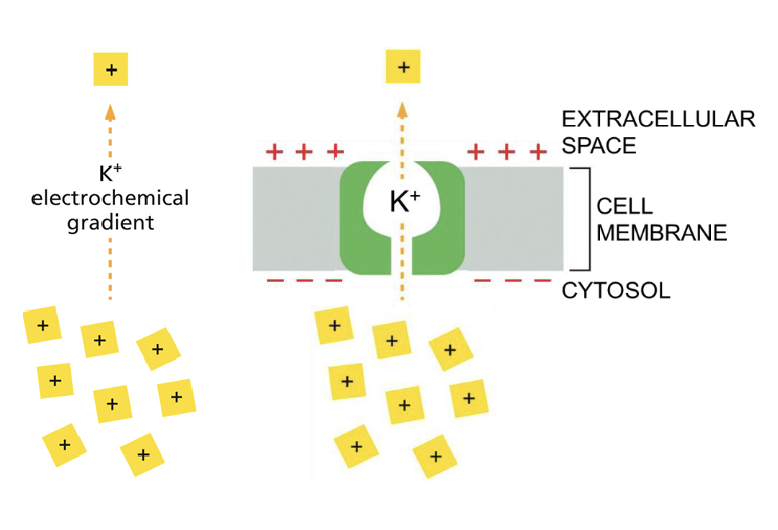
How does the sodium-potassium pump affect membrane potential?
It is responsible for 10% of membrane potential.
The pump makes sure that:
a low concentration of Na+ in the cytosol
a high concentration of K+ in the cytosol
This is done by 3 Na+ going out of the cell to the more positive side and 2 K+going into the cell, which is more negative. Therefore, the net difference in charge is 1+, where the outside of the cell is a bit more positive.
Also, due to the fixed anions in the inside of the cell, this makes the inside a bit more negative.
This forms the membrane potential.

What perspective is the membrane potential of an animal cell from?
The inside of a cell.
Quick overview of sodium potassium pump and membrane potential?
There are more Na+ in the outside of the cell (which is more positively charged)
There are more K+ in the inside of the cell (which is more negative with fixed anions)
3 Na+ out and 2 K+ in via the sodium potassium pump
This makes the outside become more positive
The potassium leak channel is also present, which makes the outside more positive too
Hence, it becomes a bit more positive in the outside, and a bit more negative in the inside of the cell
This creates the membrane potential
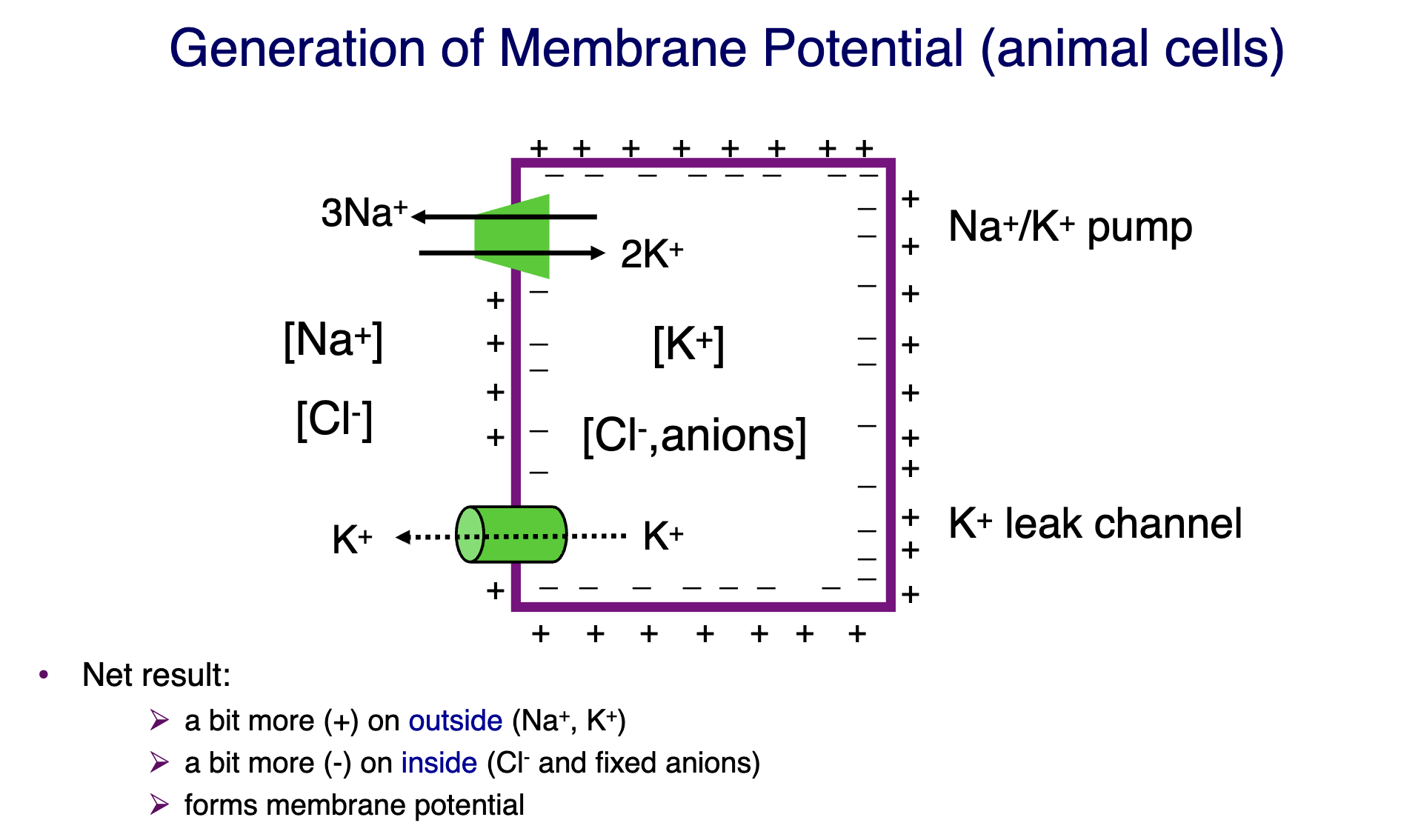
What are the concentrations of ions in each side of the membrane?
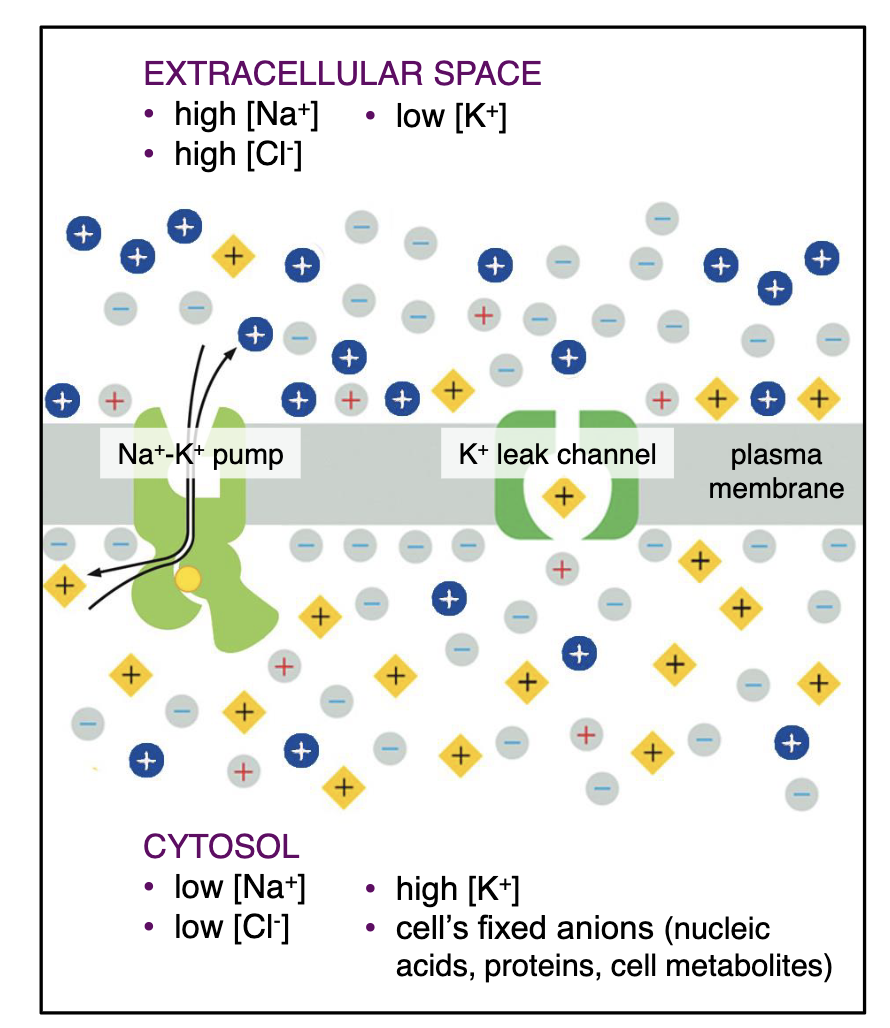
How are membrane potentials generated in plant cells?
plasma membrane p-type pump
specifically the H+ pump
generates the H+ electrochemical gradient to create a membrane potential
Used by gradient-driven pumps to carry out
active transport (e.g. H+ driven symport)Electrical signaling
Regulate pH